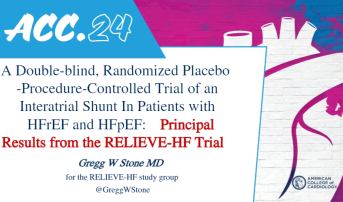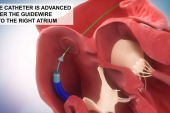Interatrial Shunt Falls Short in Sham-Controlled RELIEVE-HF
(UPDATED) Benefit was seen, however, in the HFrEF subset, hinting at a group to look at further, whereas HFpEF patients fared poorly.

ATLANTA, GA—The implantation of a Ventura (V-Wave) interatrial shunt failed to improve prognosis or reduce symptoms across a wide range of patients with heart failure (HF), results from a new randomized, sham-controlled trial show.
While the shunt was safe in the RELIEVE-HF trial, with no risk of device- or procedure-related adverse events seen at 30 days or through 2 years of follow-up, there was no difference in the primary effectiveness endpoint, a composite of all-cause mortality, left ventricular assist device (LVAD)/heart transplantation, HF hospitalizations, outpatient worsening HF events, and change in the Kansas City Cardiomyopathy Questionnaire (KCCQ), investigators reported today at the American College of Cardiology (ACC) 2024 Scientific Session.
In a surprise finding, however, the researchers did observe a significant benefit in patients who had heart failure with reduced ejection fraction (HFrEF) and a signal of harm in those with preserved ejection fraction (HFpEF).
“In patients with reduced ejection fraction, there was a 55% reduction in all cardiovascular events, and that was driven by a significant reduction in heart failure hospitalizations, with borderline reductions in the need for LVAD or heart transplant,” lead investigator Gregg Stone, MD (Icahn School of Medicine at Mount Sinai, New York), told TCTMD. Additionally, there were trends towards a reduction in all-cause mortality and worsening HF events in this group as well.
“In contrast, in patients with preserved ejection fraction, there was a substantial worsening of events with shunt treatment, a 68% increase in all events,” Stone continued. “Not only was there a doubling of heart failure hospitalizations, but there was a threefold increase in all-cause mortality.”
The number needed to treat to cause one death in those with HFpEF was nine patients, he said. These higher risks in HFpEF can’t be ignored, said Stone, adding that he believes future randomized, sham-controlled trials in this nascent space should be reserved for those with reduced LVEF.
“Given all the strong harms we saw with absolutely no signs of benefit anywhere, if I'm designing future trials of interatrial shunts, it's going to be in patients with reduced ejection fraction,” he said.
RELIEVE-HF is the second randomized, sham-controlled study investigating the use of an interatrial shunt to improve the prognosis of patients with HF. In the REDUCE-LAP II study, investigators observed no significant benefit to placing an atrial shunt in patients with HFpEF, although there were suggestions of better outcomes in a subgroup of patients without latent pulmonary vascular disease (PVD) and worse in those with latent PVD.
Sanjiv Shah, MD (Northwestern University School of Medicine, Chicago, IL), who led REDUCE-LAP II, was intrigued by the latest findings but cautioned against making too much of a single trial, particularly since there is still much to learn about which patients respond best to treatment.
“I think we have to remember that this was only one small trial,” he told TCTMD, referring to RELIEVE-HF. “Relatively speaking, we have about 250 patients in each arm. I think from a HFrEF standpoint, we certainly need further studies to make sure that this signal is real. I hope it is, that would be great for our HFrEF patients, but we'll have to see.”
He disagrees, however, with the researchers’ conclusions that interatrial shunts cause harm in HFpEF patients. The HFpEF patient population is not a monolithic group and he hopes that future trials, like RESPONDER-HF and ALLAY-HF, continue to study this patient population. “It may be that there's a sweet spot in HFpEF and there’s a sweet spot in HFrEF, and we need to better understand who those patients are,” said Shah.
Big Differences Based on LVEF
The placement of a shunt is designed to decrease pressures in the left atrium that arise in the setting of heart failure. The field has been highly competitive, with at least 10 companies developing shunts—some which leave a permanent implant, and some that don’t—in a range of sizes. The Ventura interatrial shunt, shaped like an hourglass and about the size of dime, has a small central orifice of 5.1 mm, said Stone. Implantation is straightforward, taking about 30 minutes to place the device, he said.
If I'm designing future trials of interatrial shunts, it's going to be in patients with reduced ejection fraction. Gregg Stone
The RELIEVE-HF trial randomized 508 patients with HF to the shunt or a sham procedure at 94 sites between 2018 and 2022. All were treated with guideline-directed medical therapy, including a large majority who had received an implantable cardioverter-defibrillator or who had failed cardiac resynchronization therapy. In total, more than 95% of patients were in NYHA functional class III, with only a sprinkling of patients in NYHA class II or IV. Overall, the mean LVEF was 45%, with 40% of patients with HFrEF (LVEF ≤ 40%). Biomarkers, including NT-proBNP, were markedly elevated.
“This was a very sick patient population,” said Stone, noting they were taking three HF medications on average.
At 30 days, the trial met the prespecified safety performance goal, with no reported device- or procedure-related adverse events (all-cause death, stroke, systemic embolism, or need for open surgery or endovascular surgical repair). Safety was maintained to 2 years, with no adverse events documented.
Overall, there was no significant difference in the primary effectiveness endpoint between the two study arms (weighted win ratio 0.86; P = 0.20). The annualized rate of cardiovascular events—all-cause death, need for LVAD/heart transplantation, all HF hospitalizations, and outpatient worsening HF events—was 55.7% in the shunt group and 56.0% in the placebo arm (P = 0.96). No benefit was seen in any of the individual endpoints, nor was there any significant difference between groups in the KCCQ score.
In the prespecified analysis stratifying patients based on LVEF (≤ 40% and >40%), there were marked differences in response to treatment. In those with HFrEF, the annualized rate of all cardiovascular events was 49.0% in the shunt-treated patients versus 88.6% in the placebo group (relative rate ratio 0.55; P < 0.0001), a benefit driven by significant reductions in HF hospitalizations and a borderline reduction in the need for LVAD/heart transplantation.
Event rates were reversed in those with HFpEF: the annualized rate was 60.2% in those treated with a shunt versus 35.9% in the placebo arm (P = 0.0001). The risk of all-cause mortality in shunt-treated patients with HFpEF was 16.4% versus 5.2% in the placebo arm, a statistically significant difference, while the risk of all HF hospitalizations was 37.0% per year in the shunt arm versus 19.0% per year in the placebo group (P = 0.0008).
Differences Among Trials
Scott L. Hummel, MD (University of Michigan, Ann Arbor), a HF physician who wasn’t involved in the study, said recent trials have demonstrated a significant amount of heterogeneity among shunt responders. While RELIEVE-HF wasn’t powered to show clinical effectiveness based on LVEF, the differences are “intriguing,” said Hummel, although he’s not exactly sure why those with HFrEF would have such a dramatic benefit.
When it comes to HFpEF patients, Hummel believes that this particular shunt might not be a good idea to use but noted there are other technologies, each different than the next, that might lead to a difference outcome. It’s also possible the V-Wave device may be effective in a less sick HFpEF group, for example, with a different hemodynamic profile.
Shah, likewise, said the increase in all-cause mortality in the HFpEF patients left him “scratching his head.” If there is an increased load in the right heart, as well as reduced left-sided cardiac output with the shunt, and these patients are unable to augment their cardiac output, then it’s understandable there’d be more HF hospitalizations, he said.
“But I don’t know why they would die more, other than what may be happening is that they are sicker HFpEF patients than in REDUCE-LAP II and they have other things going on,” said Shah. That same question came up during the late-breaking clinical trial session, and Stone said the deaths were driven by an increase in cardiovascular mortality, such as adjudicated HF-related or sudden cardiac deaths.
In terms of the trial, both Hummel and Shah said they’d have liked the RELIEVE-HF investigators to have performed an invasive exercise test right-heart catheterization, which would have allowed them to identify different hemodynamic phenotypes reflecting reduced pulmonary vascular or cardiac function.
In the trial, resting pulmonary vascular resistance (PVR) was 2.1 WU in the overall shunt group, and while there is no data on PVR in HFpEF patients alone, Shah suspects there is a high likelihood that RELIEVE-HF investigators selected a group of HFpEF patients unlikely to respond to the interatrial shunt. In REDUCE-LAP II, for example, those with latent pulmonary vascular disease—defined as PVR 1.7 WU or greater—did poorly when implanted with an interatrial shunt.
“That’s one thing that jumps out, that these are patient with pretty high pulmonary vascular resistance already, and that’s a patient population that we know fared worse with the atrial shunt,” said Hummel.
Biykem Bozkurt, MD, PhD (Baylor College of Medicine, Houston, TX), who spoke during the ACC session, also homed in on the differences in pulmonary capillary wedge pressures (PWCP) between the two sham-controlled trials, noting that PWCP at baseline was approximately 15.5 mm Hg in RELIEVE-HF compared with 35.0 mm Hg during exercise in REDUCE-LAP II. She questioned whether this and other baseline differences may have explained the different results.
What Happened to Quality of Life?
One of the most interesting aspects of RELIEVE-HF was the quality-of-life data assessed by the KCCQ. Overall, there was no significant improvement with the shunt compared with placebo, but there was also no difference in quality of life when patients were stratified by LVEF.
In those with HFrEF, both the shunt- and sham-treated patients had an immediate increase in the KCCQ overall summary score, but the change from baseline to 1 year was no different between the two groups. A similar finding was observed in patients with HFpEF, with no differences seen in the KCCQ score at 1 year between treatments.
“All the patients felt they got better, both the shunt-treated and control-treated patients, to a similar degree,” said Stone. “There was a big placebo effect and the KCCQ findings were totally divorced from the clinical findings, which makes it problematic to interpret this metric in blinded, and by implication, unblinded heart failure trials.”
In terms of why the HFrEF patients benefited from the shunt while those with HFpEF fared worse, Stone said they are in the midst of analyzing baseline and 1-year echocardiographic data, which will be published at a later date. However, they are seeing major differences in the way the hearts responded to the increased blood flow resulting from the shunt.
“We know that an interatrial shunt of this size created about a one liter per minute blood flow going from left to right,” he said. “For the patients with reduced ejection fraction, their hearts were compliant. They could tolerate the increase in blood flow. If you look at what happened in the right heart, right ventricular function and diameter stayed the same, pulmonary pressure stayed the same, and cardiac output stayed the same or slightly increased. So, the right heart could tolerate increased blood flow, allowing the left atrial pressure to be reduced.”
In patients with HFpEF, the heart is stiffer, said Stone. With increased blood flow, there were increases in right ventricular dimensions, pulmonary pressures substantially increased, and the cardiac output declined, indicating that the heart could not tolerate the increased flow that resulted from shunting.
Mary Norine Walsh, MD (Ascension St. Vincent Heart Center, Indianapolis, IN), past president of the ACC, who spoke with the media during a press conference, raised the concern that the study also doesn’t clarify when it might be best to intervene in HFrEF patients with such a device.
“I think a big question about the results showing such a difference between those with less than 40% and greater than 40% is: does it matter when we use this therapy in the patient's disease trajectory?” she asked. “How long would we wait after guideline-directed medical therapy intensification before we would think about this? And when is it too late and we'll be doing harm?”
Michael O’Riordan is the Managing Editor for TCTMD. He completed his undergraduate degrees at Queen’s University in Kingston, ON, and…
Read Full BioSources
Stone GW. A double-blind, randomized, placebo-procedure-controlled trial of an interatrial shunt in patients with HFrEF and HFpEF: principal results from the RELIEVE-HF trial. Presented at: ACC 2024. April 6, 2024. Atlanta, GA






Comments